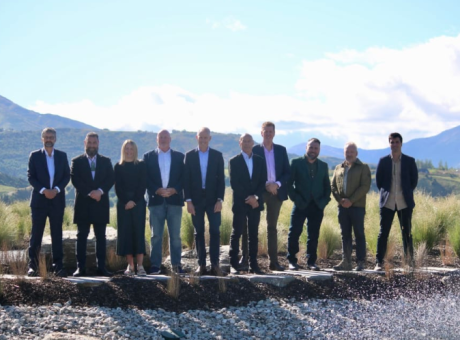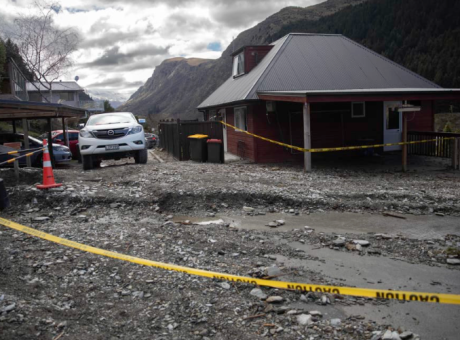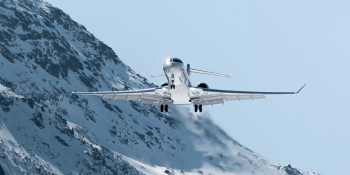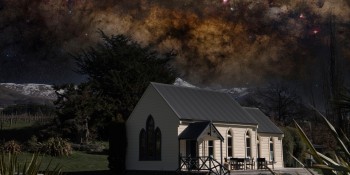What happened when the pūteketeke’s fame faded?

By Kate Newton of RNZ
On a sandy shore under the green canopy of a willow, Richard Bowman unties the rope securing a tinny, pushes off, and jumps in.
After some careful manoeuvring through the willow branches, the little boat emerges on flat, calm Lake Hayes to a view of snow-dusted Coronet Peak against a blue sky.
With him, Richard has a pair of binoculars, a clipboard and a pencil: all he needs to complete his monthly count of the lake's population of Australasian crested grebes - or pūteketeke.
If the bird's name sounds familiar, it might be because it was - controversially - crowned Forest and Bird's 'Bird of the Century' in 2023, after comedian John Oliver launched a self-proclaimed "alarmingly aggressive" global campaign to champion the pūteketeke.
But when the billboard on the Champs-Élysées got swapped out and the clips of Oliver dressed in a grebe costume dropped off the YouTube algorithm, it was people like Bowman who were still looking out for the bird.
A member of Friends of Lake Hayes, Bowman started his monthly counts of the grebes in 2019, taking over an existing survey. His fascination with these birds goes back to the 1990s, though, not long after they first started showing up at Lake Hayes.
At first, it was just the ornithologists who were excited about the grebes' arrival, he says.
"I didn't pay too much attention 'til one day I remember going around the lake - this must be in the early 90s or mid-90s - and I counted 40 pairs of birds and I thought, this is amazing."
The grebes, with their distinctive copper-coloured neck ruffs and tufts of black head feathers, are "wonderful birds to watch", Bowman says.
"They're quite tricky birds [to spot]. They spend a lot of time underwater. Interestingly, they don't spend any time on land - they have very poorly developed legs. Brilliant swimmers and divers, but I haven't actually seen one on land."
Their behaviour is also fascinating: the birds flirt by lifting themselves out of the water almost chest-to-chest, shaking their crested heads and even offering their partners some lake weed.
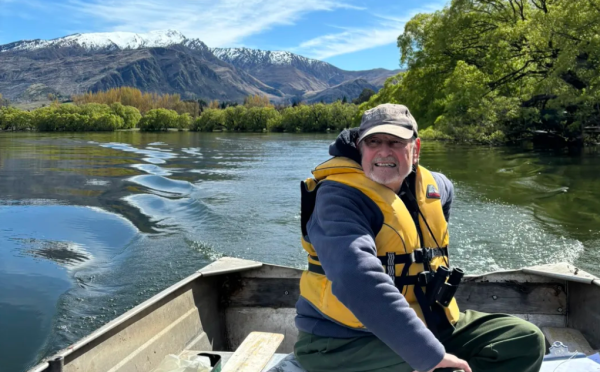
- Richard Bowman completes a circumnavigation of Lake Hayes once a month to count the lake's grebe population. Photo: RNZ / Claire Concannon
The overhanging willows encircling the lake provide perfect nesting places, along with native raupō.
"What the birds do [is] they start bringing bits of stick and nesting material and they stack it up on an overhanging branch and build themselves a little platform immediately above the water," Bowman says.
Building close to water allows the grebes to swiftly escape predators, by leaping off their nests into the lake at the slightest sign of danger.
Lake Hayes is a great habitat in other ways, too. Its water levels are relatively stable and it's sheltered, meaning no waves or fluctuating lake heights to threaten the grebes' nests. It was designated a wildlife refuge in the 1950s, limiting boat speeds to five knots.
The lake is not big - about a kilometre across and two kilometres wide. It only takes Richard an hour or two to circumnavigate in his tinny, but the counts have exceeded 170 birds at the height of the season for the last five years, and Richard's personal record since he took on the survey is 251.
He also checks some of the 40 or 50 traps around the lake's perimeter as he goes.
"By having that ring of traps around the lake every 200 metres or so on the walking track, we hopefully are going to take out predators like stoats, ferrets, rats, even feral cats."
Influxes of nutrients and sediment from the catchment have altered water quality in the lake over a number of decades, but recent catchment restoration efforts, including riparian planting and sediment traps, seem to be having a positive effect.
Elsewhere, though, the grebes need more help.
On the shore of Lake Wānaka, Markus Hermanns is busy checking and repairing nesting platforms ahead of the pūteketeke breeding season.
Unlike Lake Hayes, the water levels in Lake Wānaka vary a lot from season to season, and the wind in parts of the lake can also be strong.
When original Wānaka grebe advocate John Darby first spotted grebes at the lake just over a decade ago, he noticed that they struggled to breed as a result of these conditions, Hermanns says.
"They can't walk properly on land. So that means if they start building a nest on the shoreline and the water level drops, they can't reach the nest anymore when it sits on the dry. And the opposite - when the water level rises due to rainfall or snowmelt, the nest will float away."
So, every year, the Lake Wānaka Grebe Project puts out about 20 nesting platforms in the marina, based on Darby's original design: wooden squares with pool noodles on the bottom to help them float, two low walls to act as protection from wind, some green mesh on top as a nest base, and finally a cross of looped wire to help prevent black-backed gulls from nabbing the chicks.
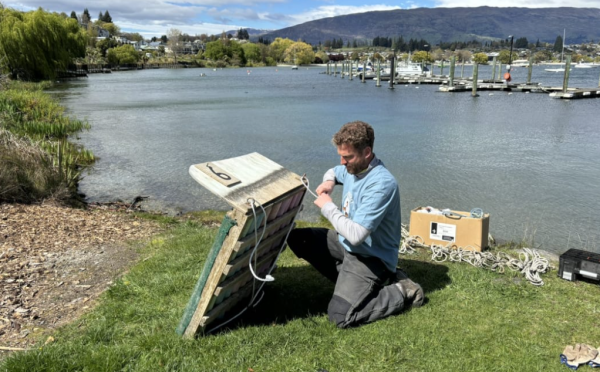
- Markus Hermanns repairs a grebe nest box on the shore of Lake Wānaka, in preparation for the year's breeding season. Photo: RNZ / Claire Concannon
The platforms are hot property among the grebes, who can nest two or even three times a season.
"Especially at high time of the breeding season - December, January, February - there is a huge pressure," Hermanns says. "As soon as they have hatched their chicks they leave or they get almost pushed out by the next pair, and they immediately lay new eggs."
The platforms have helped to attract more grebes, who in turn need space to breed. "It's a never-ending story," he says. "We would prefer if they find a habitat that's more suitable."
But there's a good reason for sustaining the Lake Wānaka project.
"We were down to around a thousand birds in New Zealand so they were almost extinct, and this project here increased the population slightly," Hermanns says.
It was likely grebes used to live as far north as the North Island, but the degradation of water quality and loss of wetlands and natural lakeshores all over the country has contributed to habitat loss.
"Until then, the breeding platforms are an artificial alternative for them to breed but it's also a way to keep the population alive, or keep the bird alive, here in New Zealand."
Hermanns hasn't noticed a surge of visitors following the pūteketeke's Bird of the Century victory, but it did help with fundraising - and the locals definitely paid attention.
"People really love having the grebes here and enjoyed all the publicity. Two children's books got published after that award as well, and they are making the rounds in the local schools, which is lovely."
He hopes that interest will help spur efforts to restore more places for the grebes to live.
"The future would be good for the grebes if the waterways get cleaner."
Main Photo: RNZ / Alison Ballance








